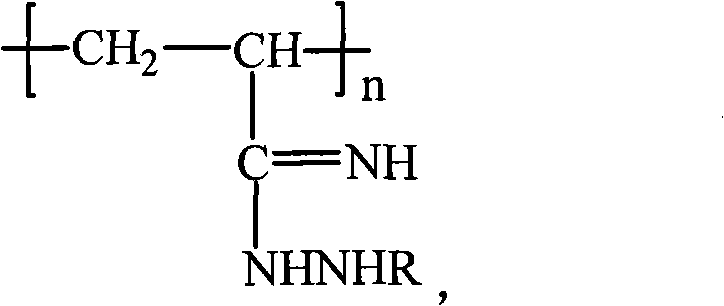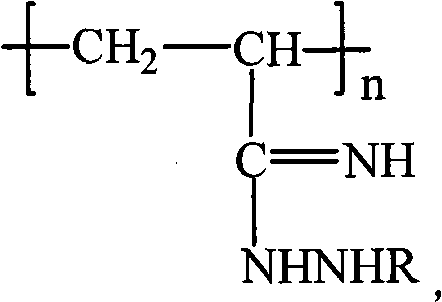Flame-retardant acrylic fibre and preparation thereof
A flame retardant acrylic fiber and solution technology, applied in textiles, papermaking, fiber processing, etc., can solve the problem of copolymer heat resistance, weather resistance, dyeability and dimensional stability decline, affecting product use effect and promotion and application, plasma generation It is easy to industrialize production, low cost and wide range of application.
Inactive Publication Date: 2010-12-08
TIANJIN POLYTECHNIC UNIV
View PDF2 Cites 0 Cited by
- Summary
- Abstract
- Description
- Claims
- Application Information
AI Technical Summary
Problems solved by technology
Although the copolymerization method is the general industrialization method adopted by flame-retardant acrylic fiber at present, the method has the following defects: it is necessary to change the original polymerization and spinning production process of conventional acrylic fiber spinning, which is inconvenient to use; when using inorganic solvent spinning , it is required that the content of flame retardant monomer in polyacrylonitrile copolymer should be ≤25wt%, and such content is difficult to meet the flame retardant requirements, such as vinyl chloride or vinylidene chloride and acrylonitrile copolymer requires vinyl chloride or vinylidene chloride The content of the flame retardant comonomer is above 40wt%; when the organic solvent is used as the spinning solvent, although the content of the flame retardant comonomer can be increased to above 40wt%, it will cause the heat resistance, weather resistance, dyeability and dimensional stability of the copolymer. The decline in performance such as resistance will affect the use effect and popularization and application of the product
Using plasma to carry out surface grafting, although the flame retardancy of the acrylic fiber or its fabric after treatment is better, the plasma generator is expensive and the operation level is high, so it is difficult to realize mass production
Method used
the structure of the environmentally friendly knitted fabric provided by the present invention; figure 2 Flow chart of the yarn wrapping machine for environmentally friendly knitted fabrics and storage devices; image 3 Is the parameter map of the yarn covering machine
View moreImage
Smart Image Click on the blue labels to locate them in the text.
Smart ImageViewing Examples
Examples
Experimental program
Comparison scheme
Effect test
preparation example Construction
Embodiment 1
Embodiment 2
the structure of the environmentally friendly knitted fabric provided by the present invention; figure 2 Flow chart of the yarn wrapping machine for environmentally friendly knitted fabrics and storage devices; image 3 Is the parameter map of the yarn covering machine
Login to View More PUM
| Property | Measurement | Unit |
|---|---|---|
| oxygen index | aaaaa | aaaaa |
| limiting oxygen index | aaaaa | aaaaa |
| limiting oxygen index | aaaaa | aaaaa |
Login to View More
Abstract
The invention relates to antiflaming acrylon and a preparation method thereof. The structural formula of the antiflaming acrylon is shown on the right, wherein, R is one out of dimethyl phosphoryl, diethyl phosphoryl, dimethyl sulfo-phosphoryl, diethyl sulfo-phosphoryl, propylene acyl, methyl propylene acyl, phosphinylidyne di-hydrazino, sulfo-phosphinylidyne di-hydrazino and sulfo-formyl hydrazine; and n is 750 to 1250. The preparation method comprises the following steps of: soaking acrylon fiber in a hydrazine solution according to the mass ratio of 1:10 to 30, heating the hydrazine solution to 80 to 100 DEG C, after reaction for 20 to 90min under the condition of stirring, taking out the acrylon fiber, being washed by water for 3 to 5 times, and obtaining the antiflaming acrylon aftervacuum drying; and the hydrazine solution is one of the following solutions: the solutions of dimethyl phosphoryl hydrazine, diethyl phosphoryl hydrazine, dimethyl sulfo-phosphoryl hydrazine, diethylsulfo-phosphoryl hydrazine, propylene acyl hydrazine, methyl propylene acyl hydrazine, phosphinylidyne tri-hydrazine, sulfo-phosphinylidyne tri-hydrazine and diamino thiourea.
Description
technical field The invention relates to an acrylic fiber preparation technology, in particular to a flame-retardant acrylic fiber without halogen elements and a method for preparing the flame-retardant acrylic fiber with a non-additional flame retardant containing nitrogen, phosphorus and sulfur. Background technique At present, there are four main ways to prepare flame-retardant acrylic fibers at home and abroad: copolymerization method, blending method, finishing method and thermal oxidation method. Copolymerization is a method commonly used in the world to manufacture flame-retardant acrylic fibers. The copolymerization method is a method for preparing flame-retardant acrylic fibers by firstly copolymerizing unsaturated monomers containing flame-retardant elements with acrylonitrile, and then using the copolymer for spinning. There are many types of flame retardant monomers used in this method, including halogen-containing compounds, phosphorus-containing compounds, ha...
Claims
the structure of the environmentally friendly knitted fabric provided by the present invention; figure 2 Flow chart of the yarn wrapping machine for environmentally friendly knitted fabrics and storage devices; image 3 Is the parameter map of the yarn covering machine
Login to View More Application Information
Patent Timeline
 Login to View More
Login to View More Patent Type & Authority Patents(China)
IPC IPC(8): D06M11/68D06M13/422D06M13/44D06M13/432D06M101/28
Inventor 程博闻任元林蒋艾兵李振环康卫民庄旭品
Owner TIANJIN POLYTECHNIC UNIV
Features
- R&D
- Intellectual Property
- Life Sciences
- Materials
- Tech Scout
Why Patsnap Eureka
- Unparalleled Data Quality
- Higher Quality Content
- 60% Fewer Hallucinations
Social media
Patsnap Eureka Blog
Learn More Browse by: Latest US Patents, China's latest patents, Technical Efficacy Thesaurus, Application Domain, Technology Topic, Popular Technical Reports.
© 2025 PatSnap. All rights reserved.Legal|Privacy policy|Modern Slavery Act Transparency Statement|Sitemap|About US| Contact US: help@patsnap.com



